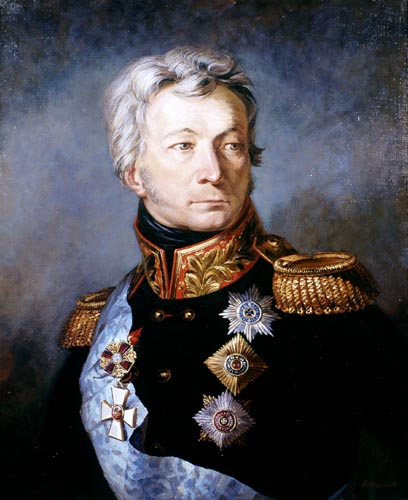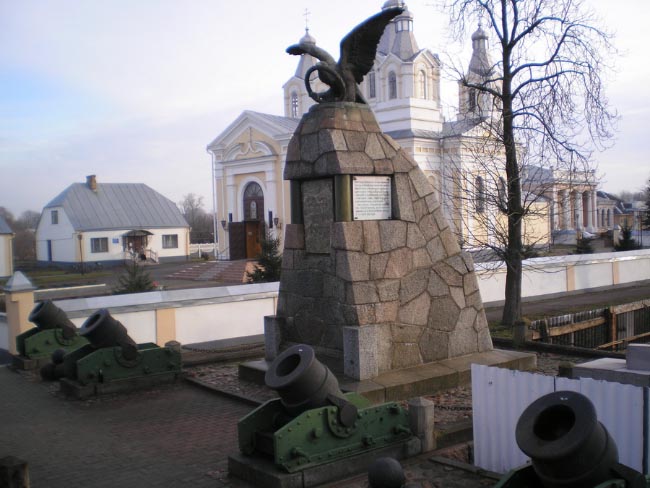Tormasov
 Alexander Petrovich Tormasov
Alexander Petrovich Tormasov
(1752-1819)
General of Cavalry,
Count (Graf)
Alexander Petrovich Tormasov was born in 1752 in a high-born noble family. He began his military service from the age of twenty, as a lieutenant ("poruchick") of the Viatka Infantry regiment. He took part in the Russian-Turkish war of 1787 - 1791, participated in the assualt of Ochakov, made several raids over the Danube river.
In the storm of the Turkish fortress Machin (in modern Romania) on March,28, 1791 Major-General Tormasov commanded the cavalry of the left flank. For this battle Tormasov was rewarded with the Order of St.George of the 3-rd Class.
Then Tormasov participated in The Second Polish ("Insurrectional") campaign of 1794. During the assault of Prague (one of suburbs of Polish capital Warsaw) he commanded one of the seven assault columns. Emperor Paul I (Pavel I) made him a chief of the Ordensky Cuirassier regiment (St.George's regiment) and promoted him to the rank of Lieutenant-General, and then suddenly dismissed him. But very soon re returned him to military service.
Alexander I who became the Russian Emperor after Paul's death, promoted Tormasov to the rank of General of Cavalry. In 1808 Tormasov was sent to the Caucasus as Commander-in-Chief of Russian troops in Georgia. He had been in the Caucasus till the beginning of 1812.
Not long before the beginning of the war of 1812 Tormasov was appointed the commander of the 3-rd Western Army. The main task of this army was to protect the Southern regions of Russia and to support the left wing of the 2-nd Western Army of General Bagration.
And just Tormasov gained the first victory in this war, he crushed the Saxon troops under General Klenchel of the Corps of Marshal Renier at the towm Kobrin on July, 15, 1812.
The town of Kobrin was defended by the most powerful Saxon detachment under the command of General Klenchel. He sent a part of his cavalry and infantry to the Brest road, but it was too late: the Saxons saw Russian cavalry and horse artillery of Count Lambert only 2 versts far from the town. The commanders tried to make some sort of fortifications, but they were too late.
General Knenchel divided his troops again. He sent some squadrons of cavalry and infantry to the Dvina road, when he knew the Russians were coming to Kobrin along this road. It was General Tormasov
It seemed for some time the enemy resisted the storm successfully: their infantry and dismounted cavalry established themselves firmly behind the stone wall of the monastery. From there, frequent volleys and single shots at the attacking Russians were heard. But the Russians moved forward persistently. They hid behind trees and houses where it was possible , and when it was not, they went openly, defying danger. Their volley sounded only near the monastery wall, and it was deadly, sweeping all defenders off the wall. Finally, the Russian burst into the monastery yard where a short, but very heated bayonet fight took place.
At the draw-bridge, Klenchel's soldiers resisted even more persistently. Their rifles and guns made attack impossible Several Russian attacks were repulsed by volleying fire. At last the volunteers came forward. Their first ranks were slaughtered at once and stained the bridge with their blood, but the ones that followed them didn't give the enemy time to reload their guns. The Russian soldiers rushed to the attack with arms raised. They swept the flimsy fortification and bayoneted all defenders - revenge for their fallen comrades. The last Saxon fortification had fallen and they hoisted a white flag.
This Russian victory caused great confusion in the French Headquarters. The Great Army troops had capitulated for the first time in the campaign. This was very good for the spirit of retreating Russian Army.
For this victory Tormasov was rewarded with the Order of St.George of the 2-nd Class.
|
|
After this battle Tormasov retreated to join the Danube Army of Admiral Chichagov (Tchichagov).
When Kutuzov became the Commander-in-Chief of the Russian Army he entrusted Tormasov all internal management of troops. And when Kutuzov was mortally ill, Tormasov was given the command of the main troops of the Russian Army, and he was at the head of the Army in the Lutzen battle.
But his health was ruined very much and this was the reason he sent in his papers and resigned, but not for a long time. Soon he became a memeber of the State Council and from 1814 he was the Moscow Commander-in-Chief. On this post in Moscow he had a lot of work to do: the city must be revived from ashes. And General Tormasov was successful in it for a very short time, and for his great services he got the title of count (Graf).
But his illness about that he had forgotten being so busy, suddenly grew acute and in autumn of 1819 Alexander Petrovich Tormasov died.

